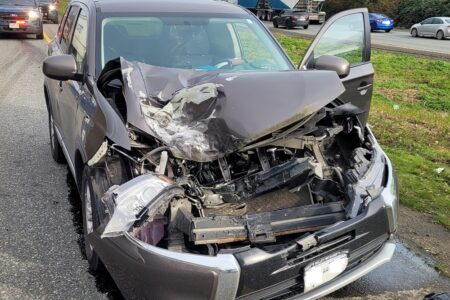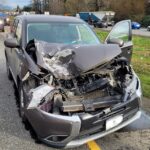DriveSmartBC: Pedestrians on the highway
“Don’t pedestrians have to use the sidewalks?” asks a reader. The concern expressed here is that when a safe place is provided for pedestrians away from traffic flow, some people choose not to use it. The reader observes that these people make life difficult for drivers by adding one more hazard on the roadway.
First, a pause for thought. A highway is not the exclusive domain of drivers. It is a public way meant for all, pedestrians, cyclists and drivers. Over time rules have evolved to define how we share this community resource. When we follow these rules we know what to expect from each other in terms of how to share safely.
The term roadway is an important one to this discussion. The roadway is the part of a highway between the yellow center line and either the solid white line at the right edge of the pavement, or if there is no solid white line then the right hand edge of the pavement.
The shoulder is the area to the right of that solid white line or to the right of the pavement edge, depending on whether the line is marked or not.
Finally, a sidewalk is the area between the side of a roadway and the adjacent property lines improved for the use of pedestrians. It does not have to be paved or concreted, simply improved in some fashion to facilitate walking there.
Drivers must not drive on and must not park on a sidewalk. The exceptions to this are when driving over it to leave the highway or when it is permitted through a bylaw.
When a passable sidewalk is present beside the highway, a pedestrian must not walk on the roadway. This does not force the pedestrian onto the sidewalk, but does require that they use either the sidewalk or the shoulder area if there is no sidewalk present on the side that they choose to walk on.
If there is no sidewalk or the sidewalk is not reasonably passable, the pedestrian must walk on the shoulder if the roadway is marked with a solid white line on the right or the extreme left side of the roadway if there is no white line.
Drivers take note, when there is no sidewalk you must be prepared to share the roadway with pedestrians. In addition, the pedestrian must walk facing the oncoming traffic.
Ultimately, it is up to the driver not to collide with a pedestrian on the highway. The definition of the word highway used here is very broad.
Pedestrians must not be on the roadway to hitch hike, solicit employment or to conduct business with the occupant of a motor vehicle.
In 2019, 49 pedestrians were killed and 2,100 injured in 2,400 collisions in British Columbia. Clearly, it is dangerous to walk beside or cross a highway. Following the rules will not guarantee that you will always be safe but it will certainly reduce the risk.
Story Long URL: https://www.drivesmartbc.ca/pedestrians/pedestrians-highway
Story Short URL: https://bit.ly/DSBC_PedOnSidewalk


























Comments